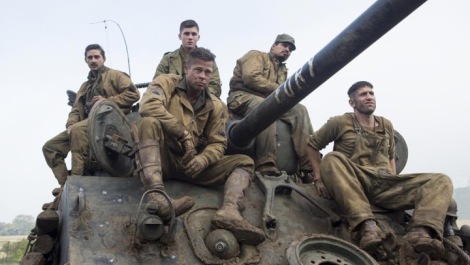Fury

There are some films that don’t just stimulate your eyes and ears. Take Fury, David Ayer’s grim, grimy but utterly gripping movie, set in April 1945 at the fag-end of WW2. You can feel the mud squelching in your toes. You can taste the blood in your mouth. And, boy, can you smell the stench of rotting corpses, burning flesh and unwashed men. This is a film that puts its boot on the back of your neck, and pushes you face-down into the shit and the scum of wartime conflict.
A former member of the US Navy, Ayer has always seasoned his scripts with real-life grit. Corrupt-cop dramas Training Day and Dark Blue and last year’s vérité-style LAPD drama End Of Watch, which he also directed, all feature a lived-in authenticity. Same goes for Fury, a film that captures the ragged, desperate hysteria at the end of WW2 – not to mention the “fanatical resistance” faced by the Allies as the troops push for victory across a war-torn Germany.
The vehicle, as it were, for Ayer’s film is a battle-scarred Sherman tank – nicknamed ‘Fury’. In charge of this beast is a US Army Sergeant named ‘Wardaddy’ (Brad Pitt), a veteran who has already fought his way through North Africa. From the moment he knifes a Nazi in the eye, you realize why he’s survived this far; he immediately recalls Robert Duvall’s Lt. Kilgore in Apocalypse Now – the sort who knows he’s not going to get so much as a scratch out there.
Forget that Nazi-scalping, swastika-carving Lt. Aldo Raine Pitt played in Quentin Tarantino’s Inglourious Basterds. With an mind-set as severe as his sides-shaved haircut, the star’s never been so brutal. Ayer reinforces this from the outset, in a shocking scene where the tank’s rookie recruit Norman Ellison (Logan Lerman) is given a baptism by fire(arms), when he’s handed a pistol and told by the Sarge to “place a big stout hole” in the back of a captured German, who otherwise would’ve done the same to him.
Never having killed before, Norman, a former pencil-pusher who has been thrown into the maelstrom, refuses to bloody his hands, only for Pitt’s character to practically force him to pull the trigger. Such is the sheer gale-force of this it’ll leave you trembling almost as much as Norman (finely acted by Noah star Lerman). But in the terms of Wardaddy, “Ideals are peaceful, history is violent” – a phrase that haunts Fury as the blood and guts of war spill out onto the screen.
Much of this is left for Norman to witness; it’s his gradual transition from innocence to experience that powers the film, acting as our way into the conflict, and Ayer doesn’t spare him (or us). One sequence sees a soldier set on fire right in front of Norman; rather than burn, the luckless grunt takes a gun and shoots himself in the head – the sort of sight that will scar a man for life. Yet it would be easy for Ayer to simply slather this report with violence and flag-waving patriotism – something he carefully avoids.
As much as Wardaddy is a fighter, he’s not a monster. Witness the crucial scene where he shows kindness to two German girls he and Norman run into (even if Ayer shamefully squeezes in a blatant shirt-off scene for Pitt, as he washes up in time for eggs and tea). Certainly, there’s humanity under the bravado – even as ‘Bible’ (Shia LaBeouf), ‘Gordo’ (Ayer’s End Of Watch star Michael Peña) and Travis (Jon Bernthal), their fellow operators in the tank, show their baser instincts.
Really, Fury recalls Wolfgang Petersen’s Das Boot: like that submarine classic, it shows how being in such a confined wartime space can generate both camaraderie and claustrophobia. The film rolls along at a thundering pace, danger hangs in the air like the shrouds of mist that DP Roman Vasyanov perfectly captures. Credit also the work of production designer Andrew Menzies, evocatively recreating wartime Germany in the English countryside of Oxfordshire and Hertfordshire.
In a way, there isn’t much more to Fury – stripped of subplots and intrigue, it offers a grunt’s-eye view of the war, with Pitt only irregularly stopping off to talk tactics with Jason Isaacs’ captain. Detractors may claim that, emotionally, Ayer never really brings out the heavy artillery, but there’s enough here for audiences to get thoroughly caught up with these spit’n’sawdust characters.
Like Norman, Ayer straps us into the front seat and doesn’t let up in anticipation of the last shell is fired of the final act – a breathless all-guns-blazing sequence that gives Pitt one of the most heroic moments he’s ever played on film. In the end, though, it’s Lerman who leaves the most lasting impression. It’s his film, really, and he grabs his chance with both hands. The result is highly memorable.
![]()












